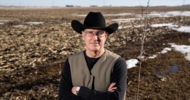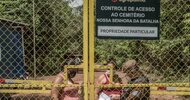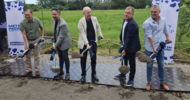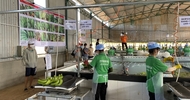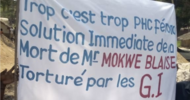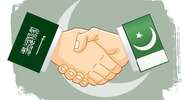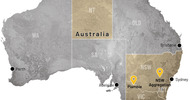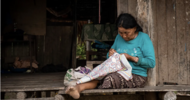Le Monde Diplomatique | 16 March 2009
Saudi Arabia has sought to secure its food supply through its own production, investment abroad since 1970s.
By Alain Gresh - PARIS
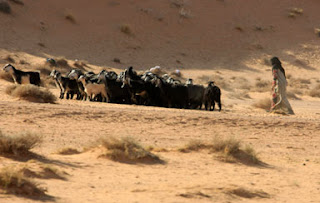
Translated by George Miller
The date-processing factories all along the desert road from Riyadh to Al-Kharj are a reminder that Saudi Arabia is the world’s biggest producer of dates. On the outskirts of Al-Kharj a large sign announces the Prince Sultan air base where, famously, US troops were stationed until 2003. A few kilometres further on, the road forks and you come to a well-guarded gate with a sign above it saying “Al-Safi -- the world’s largest integrated dairy farm.” Here, the car is disinfected and cleared to continue on its way. In the plant’s reception area a photocopied page from the 1998 Guinness Book of Records giving its vital statistics is on display: then, it had 24,000 cows and covered 3,500 hectares. Now there are 37,000 heads of cattle: black and white Holsteins, originally imported from Canada, which are artificially inseminated. The male calves are killed for meat and the females go into milk production.
Adapting dairy farming to Saudi Arabia’s climate hasn’t been easy. Refrigeration units are needed to maintain a temperature below 27C in the cowsheds and mobile sunscreens protect the animals from the scorching heat. Milking is automated and computer-controlled. On the same site is the dairy processing plant, which is also automated. It’s run by the French company Danone, a partner in the project since 2001. The farm produces 220m litres of milk per annum, which supplies one-third of the country’s needs.
The Al Safi company was the brainchild of a visionary who died two years ago, Prince Abdullah Al Faisal, the older brother of the present foreign minister. One of the prince’s proposed schemes was to tow icebergs from the North Pole to satisfy the country’s water requirements. He also wanted to make the country self-sufficient in milk. Karim Mansour, Al Safi-Danone’s young director, explained: “We get very high yields: a daily average of 33 litres per head, which is above the international average. We have 30,000 sales outlets, 25 distribution centres in Saudi Arabia and five in the Gulf, a branch in Jordan and another in Yemen, and we have plans for Lebanon and Syria. Two-and-a-half thousand people work here [plus another thousand at the farm in which Danone is not a partner]. One-quarter of the staff are Indian and one-quarter Saudi. Employing Saudis has been a challenge: it’s hard to find nationals to do manual jobs, but we make an effort to find them in poor regions such as the south and the east.”
A plume of steam drifts from a wooden hut where water is being pumped from underground at a temperature of 70C. Originally it was drawn from a depth of 200m, but now it has to come from 2,000m below ground. By way of justification, Mansour says: “We used to grow our forage here, but we’ve moved to fields 200 kilometres away so as not to exhaust the water table. We also have a water recycling policy.” And he assures me that animal husbandry only uses 3-4% of the country’s water supply, whereas arable cultivation consumes more than 80%.
Attaining self-sufficiency
Few people are aware that Saudi Arabia transformed itself in the 1980s into a significant wheat producer. The government guaranteed farmers a purchase price higher than the world market price and the country became self-sufficient in 1984. The area under arable cultivation rose from 67,000 hectares in 1980 to 907,000 in 1992 and yields improved from 2.12 tonnes per hectare in 1980 to 4.7 by 1988 and then 5.19 in 2005. (In comparison, the average yield in France is 6.98, in China 4.22 and in Austria 5.03.) Private companies were set up and made hefty profits. Peak production was reached in 1993 (5.3m tonnes), enabling the country to export more than 2m tonnes. At the time, the UN’s Food and Agriculture Organisation congratulated the country on its performance.
The desert kingdom is not all arid land and has, especially in the north and the south, green and fertile areas, but wheat production on this scale required tens of thousands of hectares to be reclaimed from the desert. To understand the logic of this, you have to go back to the 1970s and the petrol boom that came after 1973. Then, the third world dreamed of a new international economic order and the West threatened to use food as a weapon by cutting off wheat and milk exports to states it deemed hostile. A number of governments, including ones which were not of a progressive nature, declared a desire to achieve national food security. Saudi Arabia was one of them. Official brochures from that time express that desire in language similar to that of “socialist” Algeria. Vast oil revenues seemed to open all sorts of doors, including one leading to massive milk production.
“We’ve become the main water exporter in the region,” explained an agricultural engineer who wanted to remain anonymous. “We’re producing wheat, fruit and vegetables, which we sell to our neighbours and which is using up our water resources.” Along with his fellow professionals, he’s been trying to draw this to the attention of the authorities. There’s been a heated debate between advocates of food security and those who want to conserve the country’s water supply. In the end, as far as wheat is concerned, it was the water-conservers who won. The government decided on a progressive scaling-down of wheat production subsidies and they will be phased out altogether between now and 2016. This year, for the first time in 25 years, Saudi Arabia will buy 300,000 tonnes of wheat on the international market.
Unlike many politicians, the Saudi deputy minister for agriculture, Dr Abdullah al-Obeid, doesn’t mince his words. He was a member of the delegation that negotiated his country’s membership of the World Trade Organisation, which Saudi Arabia joined in 2005. He told me: “At the ministry, we thought we should maintain our wheat production. We were achieving high yields, especially in the north, of eight to 10 tonnes per hectare, and there we have less of a problem with water. We would like to have kept production in the north.”
Turki Faisal al-Rasheed is president of Golden Grass Inc., a major Saudi agricultural company. While he was at prayer, I looked at the articles and press releases in the company’s press book. He was an observer of the recent Kuwaiti elections and is an advocate of a parliamentary system for his own country. He shares al-Obeid’s reservations: “All countries have water problems, even the US. But we have to go on growing. That allows us to help poor rural areas and also helps us to master up-to-date agricultural technologies, which saves water. It would have been better to link subsidies to the use of Saudi labour.” A number of businessmen who lost out with the withdrawal of wheat subsidies boycotted the agricultural trade fair last November.
Food security continues to preoccupy Saudi officials. “The food crisis in the spring of 2008 was a warning sign,” according to al-Obeid. Saudi Arabia is a net importer of agricultural products, especially rice, corn and soya. This fact is pushing the state to invest overseas. We’ve sent government and private-sector delegations to Turkey, Ukraine, Egypt, Sudan, Thailand, the Philippines, Vietnam, Ethiopia and Uzbekistan. These delegations have been very warmly received.” He rejects the suggestion that this is a neo-colonialist venture, and deplores the lurid fantasies of the international press: “We want to invest in agriculture abroad, but we don’t want to monopolise the entire output for ourselves. Quite the reverse: We plan to expand the total area under cultivation and guarantee that a proportion of the harvest will stay in the producer country.”
Fears of massive investment by the Arab world in the agriculture of the South have been front-page news in recent months. A “rush for arable land” was how Le Monde put it (13 December 2008). The paper published a map produced by the NGO Grain (grain.org), which claimed that Saudi Arabia, for example, had bought up precisely 1,610,117 hectares. “States which are grabbing agricultural land in Africa” were denounced by the site Afrik.com on 12 December. “Getting their mitts on agricultural land in the South” was how a schoolteacher explained it to his students on his blog.
“There’s been a lot of talk about investment in Sudan,” al-Rasheed concedes. He himself has written several articles about it in the local press. “Sudan has a number of attractions: it has a huge area of cultivatable land, only 20% of which is currently being used. It has water in abundance from rain and the Nile. And it has a favourable climate.” Even back in the 1970s Sudan was being touted as the breadbasket of the Arab world. “And yet,” according to al-Rasheed, “there are numerous obstacles: In addition to the poverty of Sudanese agriculture, its artisanal character and technical backwardness, there is no clear system of land ownership. And the land proposed for cultivation is in petroleum regions and so is vulnerable to future take-over. Infrastructure in the country is rudimentary. When all of that has been sorted out -- and it’s mainly the responsibility of the authorities in Khartoum -- then we can invest. But it’s not just around the corner.” The other Eldorado which is often cited, Egypt, presents similar problems, according to al-Rasheed. And Asia is simply too far away.
A western presence
Overseas private investment in agriculture is nothing new. Western nations have had a presence in their former colonies for several hundred years and the situation didn’t change very much when those colonies gained independence. The price rises in agricultural products in 2008, though short-lived, have probably increased the desire. But conception is one thing and execution another – and it is a bit rich to denounce the Gulf states for harbouring colonial ambitions towards the world’s agricultural land. All the more so, as private investors who grow rice or wheat are unlikely to keep it for their home country; they’ll want to sell it on the world market to the highest bidder.
The NGO Grain has produced a list of agricultural investment projects for 2008 arranged by country. When it comes to Saudi Arabia and the Gulf states, it’s nearly always a case of plans, visits and intentions rather than signed contracts. Even the agreement quoted as a done deal between the Saudi Bin Laden group and Indonesia ($4.3bn to develop half a million hectares of basmati rice, which Saudi consumers are especially fond of) seems still to be at the planning stage. And the financial crisis, added to the reduction of agricultural prices (even if only temporary), will also limit many potential investors’ appetites.
With a rapidly growing population and ground water that is either running out or becoming polluted -- a detailed picture of the country’s water resources has yet to be made -- plans to rationalise the construction of new desalination plants will not be enough to cater for the country’s future water needs. No one is talking about hauling icebergs from the North Pole any more, so Saudi Arabia needs to find new ways of guaranteeing its food security.
Alain Gresh is editor of Le Monde diplomatique and a specialist on the Middle East.
Saudi Arabia has sought to secure its food supply through its own production, investment abroad since 1970s.
By Alain Gresh - PARIS

Translated by George Miller
The date-processing factories all along the desert road from Riyadh to Al-Kharj are a reminder that Saudi Arabia is the world’s biggest producer of dates. On the outskirts of Al-Kharj a large sign announces the Prince Sultan air base where, famously, US troops were stationed until 2003. A few kilometres further on, the road forks and you come to a well-guarded gate with a sign above it saying “Al-Safi -- the world’s largest integrated dairy farm.” Here, the car is disinfected and cleared to continue on its way. In the plant’s reception area a photocopied page from the 1998 Guinness Book of Records giving its vital statistics is on display: then, it had 24,000 cows and covered 3,500 hectares. Now there are 37,000 heads of cattle: black and white Holsteins, originally imported from Canada, which are artificially inseminated. The male calves are killed for meat and the females go into milk production.
Adapting dairy farming to Saudi Arabia’s climate hasn’t been easy. Refrigeration units are needed to maintain a temperature below 27C in the cowsheds and mobile sunscreens protect the animals from the scorching heat. Milking is automated and computer-controlled. On the same site is the dairy processing plant, which is also automated. It’s run by the French company Danone, a partner in the project since 2001. The farm produces 220m litres of milk per annum, which supplies one-third of the country’s needs.
The Al Safi company was the brainchild of a visionary who died two years ago, Prince Abdullah Al Faisal, the older brother of the present foreign minister. One of the prince’s proposed schemes was to tow icebergs from the North Pole to satisfy the country’s water requirements. He also wanted to make the country self-sufficient in milk. Karim Mansour, Al Safi-Danone’s young director, explained: “We get very high yields: a daily average of 33 litres per head, which is above the international average. We have 30,000 sales outlets, 25 distribution centres in Saudi Arabia and five in the Gulf, a branch in Jordan and another in Yemen, and we have plans for Lebanon and Syria. Two-and-a-half thousand people work here [plus another thousand at the farm in which Danone is not a partner]. One-quarter of the staff are Indian and one-quarter Saudi. Employing Saudis has been a challenge: it’s hard to find nationals to do manual jobs, but we make an effort to find them in poor regions such as the south and the east.”
A plume of steam drifts from a wooden hut where water is being pumped from underground at a temperature of 70C. Originally it was drawn from a depth of 200m, but now it has to come from 2,000m below ground. By way of justification, Mansour says: “We used to grow our forage here, but we’ve moved to fields 200 kilometres away so as not to exhaust the water table. We also have a water recycling policy.” And he assures me that animal husbandry only uses 3-4% of the country’s water supply, whereas arable cultivation consumes more than 80%.
Attaining self-sufficiency
Few people are aware that Saudi Arabia transformed itself in the 1980s into a significant wheat producer. The government guaranteed farmers a purchase price higher than the world market price and the country became self-sufficient in 1984. The area under arable cultivation rose from 67,000 hectares in 1980 to 907,000 in 1992 and yields improved from 2.12 tonnes per hectare in 1980 to 4.7 by 1988 and then 5.19 in 2005. (In comparison, the average yield in France is 6.98, in China 4.22 and in Austria 5.03.) Private companies were set up and made hefty profits. Peak production was reached in 1993 (5.3m tonnes), enabling the country to export more than 2m tonnes. At the time, the UN’s Food and Agriculture Organisation congratulated the country on its performance.
The desert kingdom is not all arid land and has, especially in the north and the south, green and fertile areas, but wheat production on this scale required tens of thousands of hectares to be reclaimed from the desert. To understand the logic of this, you have to go back to the 1970s and the petrol boom that came after 1973. Then, the third world dreamed of a new international economic order and the West threatened to use food as a weapon by cutting off wheat and milk exports to states it deemed hostile. A number of governments, including ones which were not of a progressive nature, declared a desire to achieve national food security. Saudi Arabia was one of them. Official brochures from that time express that desire in language similar to that of “socialist” Algeria. Vast oil revenues seemed to open all sorts of doors, including one leading to massive milk production.
“We’ve become the main water exporter in the region,” explained an agricultural engineer who wanted to remain anonymous. “We’re producing wheat, fruit and vegetables, which we sell to our neighbours and which is using up our water resources.” Along with his fellow professionals, he’s been trying to draw this to the attention of the authorities. There’s been a heated debate between advocates of food security and those who want to conserve the country’s water supply. In the end, as far as wheat is concerned, it was the water-conservers who won. The government decided on a progressive scaling-down of wheat production subsidies and they will be phased out altogether between now and 2016. This year, for the first time in 25 years, Saudi Arabia will buy 300,000 tonnes of wheat on the international market.
Unlike many politicians, the Saudi deputy minister for agriculture, Dr Abdullah al-Obeid, doesn’t mince his words. He was a member of the delegation that negotiated his country’s membership of the World Trade Organisation, which Saudi Arabia joined in 2005. He told me: “At the ministry, we thought we should maintain our wheat production. We were achieving high yields, especially in the north, of eight to 10 tonnes per hectare, and there we have less of a problem with water. We would like to have kept production in the north.”
Turki Faisal al-Rasheed is president of Golden Grass Inc., a major Saudi agricultural company. While he was at prayer, I looked at the articles and press releases in the company’s press book. He was an observer of the recent Kuwaiti elections and is an advocate of a parliamentary system for his own country. He shares al-Obeid’s reservations: “All countries have water problems, even the US. But we have to go on growing. That allows us to help poor rural areas and also helps us to master up-to-date agricultural technologies, which saves water. It would have been better to link subsidies to the use of Saudi labour.” A number of businessmen who lost out with the withdrawal of wheat subsidies boycotted the agricultural trade fair last November.
Food security continues to preoccupy Saudi officials. “The food crisis in the spring of 2008 was a warning sign,” according to al-Obeid. Saudi Arabia is a net importer of agricultural products, especially rice, corn and soya. This fact is pushing the state to invest overseas. We’ve sent government and private-sector delegations to Turkey, Ukraine, Egypt, Sudan, Thailand, the Philippines, Vietnam, Ethiopia and Uzbekistan. These delegations have been very warmly received.” He rejects the suggestion that this is a neo-colonialist venture, and deplores the lurid fantasies of the international press: “We want to invest in agriculture abroad, but we don’t want to monopolise the entire output for ourselves. Quite the reverse: We plan to expand the total area under cultivation and guarantee that a proportion of the harvest will stay in the producer country.”
Fears of massive investment by the Arab world in the agriculture of the South have been front-page news in recent months. A “rush for arable land” was how Le Monde put it (13 December 2008). The paper published a map produced by the NGO Grain (grain.org), which claimed that Saudi Arabia, for example, had bought up precisely 1,610,117 hectares. “States which are grabbing agricultural land in Africa” were denounced by the site Afrik.com on 12 December. “Getting their mitts on agricultural land in the South” was how a schoolteacher explained it to his students on his blog.
“There’s been a lot of talk about investment in Sudan,” al-Rasheed concedes. He himself has written several articles about it in the local press. “Sudan has a number of attractions: it has a huge area of cultivatable land, only 20% of which is currently being used. It has water in abundance from rain and the Nile. And it has a favourable climate.” Even back in the 1970s Sudan was being touted as the breadbasket of the Arab world. “And yet,” according to al-Rasheed, “there are numerous obstacles: In addition to the poverty of Sudanese agriculture, its artisanal character and technical backwardness, there is no clear system of land ownership. And the land proposed for cultivation is in petroleum regions and so is vulnerable to future take-over. Infrastructure in the country is rudimentary. When all of that has been sorted out -- and it’s mainly the responsibility of the authorities in Khartoum -- then we can invest. But it’s not just around the corner.” The other Eldorado which is often cited, Egypt, presents similar problems, according to al-Rasheed. And Asia is simply too far away.
A western presence
Overseas private investment in agriculture is nothing new. Western nations have had a presence in their former colonies for several hundred years and the situation didn’t change very much when those colonies gained independence. The price rises in agricultural products in 2008, though short-lived, have probably increased the desire. But conception is one thing and execution another – and it is a bit rich to denounce the Gulf states for harbouring colonial ambitions towards the world’s agricultural land. All the more so, as private investors who grow rice or wheat are unlikely to keep it for their home country; they’ll want to sell it on the world market to the highest bidder.
The NGO Grain has produced a list of agricultural investment projects for 2008 arranged by country. When it comes to Saudi Arabia and the Gulf states, it’s nearly always a case of plans, visits and intentions rather than signed contracts. Even the agreement quoted as a done deal between the Saudi Bin Laden group and Indonesia ($4.3bn to develop half a million hectares of basmati rice, which Saudi consumers are especially fond of) seems still to be at the planning stage. And the financial crisis, added to the reduction of agricultural prices (even if only temporary), will also limit many potential investors’ appetites.
With a rapidly growing population and ground water that is either running out or becoming polluted -- a detailed picture of the country’s water resources has yet to be made -- plans to rationalise the construction of new desalination plants will not be enough to cater for the country’s future water needs. No one is talking about hauling icebergs from the North Pole any more, so Saudi Arabia needs to find new ways of guaranteeing its food security.
Alain Gresh is editor of Le Monde diplomatique and a specialist on the Middle East.



